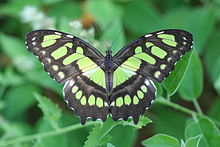- Siproeta stelenes
-
Siproeta stelenes 

Scientific classification Kingdom: Animalia Phylum: Arthropoda Class: Insecta Order: Lepidoptera Family: Nymphalidae Tribe: Victorinini Genus: Siproeta Species: S. stelenes Binomial name Siproeta stelenes
(Linnaeus, 1758)Siproeta stelenes, commonly known as the Malachite, is a neotropical brush-footed butterfly (family Nymphalidae). The malachite has large wings that are black and brilliant green or yellow-green on the uppersides and light brown and olive green on the undersides. It is named for the mineral malachite, which is similar in color to the bright green on the butterfly's wings. The wingspread is typically between 8.5 and 10 cm (3.3 and 3.9 in). The malachite is found throughout Central and northern South America, where it is one of the most common butterfly species. Its distribution extends as far north as southern Texas and the tip of Florida, to Cuba, as subspecies S. s. insularis (Holland, 1916), and south to Brazil.
Adults feed on flower nectar, rotting fruit, dead animals, and bat dung. Females lay eggs on the new leaves of plants in the Acanthaceae family, especially ruellia. The larvae are horned, spiny black caterpillars with red markings.
Malachites are often confused with Philaethria dido. They have similar coloration, but their wing shapes are different.[1]
References
- ^ "Malachite". Butterflies of the Amazon and Andes. http://www.learnaboutbutterflies.com/Andes%20-%20Siproeta%20stelenes.htm. Retrieved July 30, 2011.
External links
 Media related to Siproeta stelenes at Wikimedia Commons
Media related to Siproeta stelenes at Wikimedia Commons- Malachite fact sheet
- The Butterfly Project: Siproeta stelenes

This Nymphalinae article is a stub. You can help Wikipedia by expanding it.
